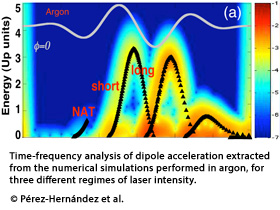Home > Press > Water window imaging opportunity: A new theoretical study elucidates mechanisms that could help in producing coherent radiations, ultimately promoting high-contrast imaging of biological samples
 |
Abstract:
Ever heard of the water window? It consists of radiations in the 3.3 to 4.4 nanometre range, which are not absorbed by the water in biological tissues. New theoretical findings show that it is possible to develop coherent radiations within the water window. These could be the basis of an optimal technique to obtain a high-contrast image of the biological samples or to be used in high-precision spectroscopy. Now, a new theoretical study identifies the physical mechanism needed to efficiently generate the harmonic radiations—which are multiples of an incoming laser's frequency—at high laser intensities that occur beyond the saturation threshold of atoms and molecules. These findings, aimed at improving conventional methods of coherent radiation production to reach the water window, were recently published in the EPJ D by José Pérez-Hernández from the Centre for Pulsated Laser, CLPU, in Salamanca, Spain, and colleagues.
Water window imaging opportunity: A new theoretical study elucidates mechanisms that could help in producing coherent radiations, ultimately promoting high-contrast imaging of biological samples
Heidelberg, Germany and New York, NY | Posted on August 21st, 2014When an intense and short laser pulse interacts with an atom or molecule, one of the resultant physical processes is the High-order Harmonic Generation (HHG) process, which is capable of changing the driving laser pulse into new harmonic frequencies. HHG also provides a direct way to synthesise atto-second pulses (10-18s range) and produce coherent radiation in the extreme UV range, dubbed XUV and EUV.
In previous similar work, studies focused on hydrogen as the atomic target. In the present work, the authors extend the study to argon atoms—a gas typically providing a high enough frequency conversion efficiency to detect the HHG. The authors use the same formalism as in hydrogen studies, consisting in mathematical equations combined with a quantum mechanical approach using numerical computation and providing a quantitative description of the HHG spectrum. The experimental confirmation of the reported prediction, however, still remains a challenge.
####
For more information, please click here
Contacts:
Laura Zimmermann
Springer
Corporate Communications
tel +49 6221 487 8414
Copyright © Springer
If you have a comment, please Contact us.Issuers of news releases, not 7th Wave, Inc. or Nanotechnology Now, are solely responsible for the accuracy of the content.
| Related Links |
| Related News Press |
News and information
![]() Simulating magnetization in a Heisenberg quantum spin chain April 5th, 2024
Simulating magnetization in a Heisenberg quantum spin chain April 5th, 2024
![]() NRL charters Navy’s quantum inertial navigation path to reduce drift April 5th, 2024
NRL charters Navy’s quantum inertial navigation path to reduce drift April 5th, 2024
![]() Discovery points path to flash-like memory for storing qubits: Rice find could hasten development of nonvolatile quantum memory April 5th, 2024
Discovery points path to flash-like memory for storing qubits: Rice find could hasten development of nonvolatile quantum memory April 5th, 2024
Imaging
![]() Nanoscale CL thermometry with lanthanide-doped heavy-metal oxide in TEM March 8th, 2024
Nanoscale CL thermometry with lanthanide-doped heavy-metal oxide in TEM March 8th, 2024
![]() The USTC realizes In situ electron paramagnetic resonance spectroscopy using single nanodiamond sensors November 3rd, 2023
The USTC realizes In situ electron paramagnetic resonance spectroscopy using single nanodiamond sensors November 3rd, 2023
![]() Observation of left and right at nanoscale with optical force October 6th, 2023
Observation of left and right at nanoscale with optical force October 6th, 2023
Discoveries
![]() Chemical reactions can scramble quantum information as well as black holes April 5th, 2024
Chemical reactions can scramble quantum information as well as black holes April 5th, 2024
![]() New micromaterial releases nanoparticles that selectively destroy cancer cells April 5th, 2024
New micromaterial releases nanoparticles that selectively destroy cancer cells April 5th, 2024
![]() Utilizing palladium for addressing contact issues of buried oxide thin film transistors April 5th, 2024
Utilizing palladium for addressing contact issues of buried oxide thin film transistors April 5th, 2024
Announcements
![]() NRL charters Navy’s quantum inertial navigation path to reduce drift April 5th, 2024
NRL charters Navy’s quantum inertial navigation path to reduce drift April 5th, 2024
![]() Discovery points path to flash-like memory for storing qubits: Rice find could hasten development of nonvolatile quantum memory April 5th, 2024
Discovery points path to flash-like memory for storing qubits: Rice find could hasten development of nonvolatile quantum memory April 5th, 2024
Interviews/Book Reviews/Essays/Reports/Podcasts/Journals/White papers/Posters
![]() Simulating magnetization in a Heisenberg quantum spin chain April 5th, 2024
Simulating magnetization in a Heisenberg quantum spin chain April 5th, 2024
![]() Discovery points path to flash-like memory for storing qubits: Rice find could hasten development of nonvolatile quantum memory April 5th, 2024
Discovery points path to flash-like memory for storing qubits: Rice find could hasten development of nonvolatile quantum memory April 5th, 2024
|
|
||
|
|
||
| The latest news from around the world, FREE | ||
|
|
||
|
|
||
| Premium Products | ||
|
|
||
|
Only the news you want to read!
Learn More |
||
|
|
||
|
Full-service, expert consulting
Learn More |
||
|
|
||








